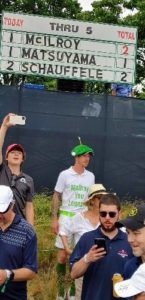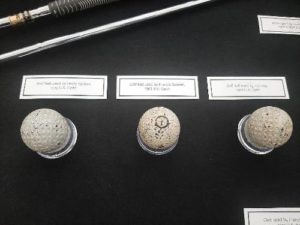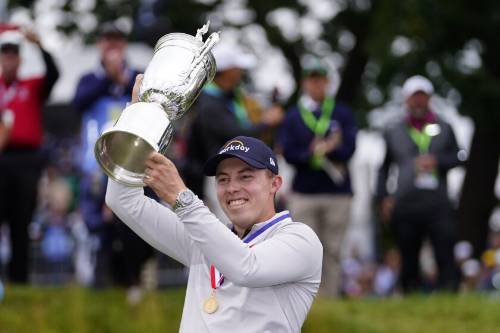
BROOKLINE, MA – Ever since network television broadcast Ben Hogan bringing “the Monster” that was a Robert Trent Jones, Sr.-sharpened Oakland Hills South Course to its knees in the 1951 U.S. Open there has been one inescapable mantra:
At a proper U.S. Open, the golf course is the star.
Oakmont, Winged Foot, Pebble Beach, Pinehurst, Olympic Club – some courses define the U.S. Open. Whether ferocious rough and flummoxing green contours, rubbery ice plant and sun-drenched rocky coast line, or incomparable history and complex strategies, the golf course is the headliner, the main attraction. The players change over the intervening decades, but the course always emerges victorious, usually devouring much of the field before fading back into the mists of history like a reverie.
Joyously, a new generation of golf fans can add Brookline, Massachusetts’s The Country Club to that list of storied venues. We don’t visit TCC (as it’s known to its friends in golf) as often as we should because of its small footprint. Tucked cozily in a verdant, leafy, and sleepy suburban neighborhood, the Open infrastructure had to be slashed to a fraction of its normal size in order to stage the tournament at Brookline, but there’s heart-stopping drama every time the U.S. Open comes.
The 2022 Open will only add to the majesty of the club’s nigh-unparalleled history. England’s latest young lion of a golfer, Matthew Fitzpatrick, accomplished a particularly rare two-fer in golf: winning the U.S. Open at the same venue where we won the U.S. Amateur (2013). Only Jack Nicklaus and Tiger Woods have accomplished that as well. Nice company.

The shot of the tournament was a mighty 9-iron from out of a dreadful lie from the left fairway bunker at the 72nd hole that will echo in golf history across the pond for well over a century. And that echo will resound thusly: REVENGE!
It was on every UK-centric lip: from BBC broadcaster Ian Carter to the Euro fan dressed as a leprechaun in a jumper reading “MCILROY YOU LEGEND!” and everyone in between. Revenge! – Revenge for Vardon and Ray in 1913, revenge for Faldo in ’88, and bloody damn revenge for the ’99 Ryder Cup….all the more satisfying since it looked, for all the world, like English fans would endure another horrid, heart-wrenching TCC collapse.
Clinging to a one-shot lead, and with all of the United Kingdom and Ireland having already bitten their collective fingernails to the quick, Fitzgerald stepped to the 72nd tee bloodied, but not bowed by the relentless donnybrook he was battling with Americans Scottie Scheffler and Will Zalatoris. But there was so much more to overcome than the last two remaining rivals and the 72nd hole; there was the century-plus of European failure at The Country Club. To the UK golf consciousness, The Country Club is the golf equivalent OF Saratoga, Yorktown, and the sinking of the Serapis by the Bonhamme Richard all rolled into one.
Now a brief reminder is in order: The 72nd hole of a major is never – ever – a pushover. And that goes double at a U.S. Open.
The last time we were gathered a golf major – just a month ago at Tulsa’s Southern Hills for the PGA Championship – a blithe and friendly Chilean fellow named Mito Pereira came to the 72nd hole with a one shot lead and left in infamy, carding a double bogey and missing out on a playoff between two golfers who, by all rights, should have T-2nd to Pereira. Pereira adds his name to an endless list of 72nd hole collapses: Mickelson, Palmer, Van de Velde, and Dustin Johnson (twice) just to name a fistful. And just the evening prior, the defending U.S. Open Champion, Jon Rahm, came to the 18th with a one shot lead and carded double bogey when he…wait for it…tried to get too cute going for the green out of a fairway bunker. Rahm fell out of the final pairing and never recovered; he was a non-factor on Sunday, closing with a 74.
So with all that as antecedent, when Fitzpatrick drove into that hair-raising lie in the bunker on 18, you could forgive everyone in the UK for fearing they were watching yet another snuff film.
But no, the fresh-faced, wholesome-seeming kid – who loves nothing more complicated than Mum and Da, wimpies and whipsies, (that’s burgers and shakes), and cold, blustery vacations in places like Blackpool – the kid hit the shot of his life. Never in doubt, the towering 9-iron laced perfectly into the heart of the green for a two-putt par. Zalatoris had one final chance to tie, but his 20-foot birdie attempt agonizingly slid last the left edge.

It was well deserved: Fitzpatrick echoed the pattern that worked in 2013 when he won the 2013 final 4 and 3 over Oliver Goss: fairways and greens. Fitzpatrick finished T-2nd in fairways hit, T-1st in greens in regulation for the week (73%), including a David Graham-like 17 of 18 greens on Sunday, and he led the field in birdies.
Moreover, with the new-found length he’s acquired this season, Fitzpatrick was able to exploit what little soft underbelly exists at TCC. Fitzpatrick reached the rollicking par-5 eighth hole in two all four days, carding four birdies, including one on Sunday that aided his rise to the top of the leaderboard. He also was able to drive the short, 300-yard par-4 fifth hole, and birdied that hole all four days. His closing 68 was tied for second lowest round of the day and was his third 68 of the week.
Meanwhile it was Zalatoris’s second straight runner-up finish in a major and his third in the last nine. He’s also had two T-6s and a T-8th in that span.
“It stings, obviously, to have three runner-ups so far in my career in majors, but I’ll keep knocking on that door,” he said optimistically. “We’re obviously doing the right things. I’d pay a lot of money for about an inch and a half, and I’d probably be a three-time major champion at this point.”

Better still, The Country Club and the USGA hit every note pitch perfectly. Where normally players bellyache about U.S. Open setups, the players were uniform in both their praise of the rough, the green speeds, and the conditioning.
How nice is it to have a U.S. Open where nobody complains. Nobody.
Many pundits chalk that up to Mike Davis’s graded rough. Now, 16 years into his game-changing gamble, while driving accuracy matters somewhat less, greens in reg and putting are still the winning formula. Little has changed other than players have a chance for a dramatic recovery: they no longer have to hack out of the rough with a lob wedge, and fast and firm conditions promote a galaxy of strategic options.
In a few short years, the U.S. Open has gone from the tournament that many thought was tricked-up to being eminently fair without losing one iota of their imprimatur: to be the toughest tournament in professional golf.
Better still, Boston was a sparkling backdrop. Fenway lights burned brightly in the evenings, the Celtics electrified everyone with their gallant run to the NBA Finals, and the golf course proved close to unconquerable. A devastating synergy of golf history, strategy, and majesty, why not come back to Brookline soon and often? It’s been a stupendous week. Perhaps the USGA might consider anointing TCC “Golf House Boston” or another anchor site.
But there is better news still. The biggest winner this week was American golf. The new, rogue Saudi Royal family-funded LIV Tour may have burned like a torch over this U.S. Open on Thursday morning, but its players certainly didn’t shine come Sunday afternoon. Of the 14 LIV Tour players at the Open, only four made the cut. Worse still, none of those four was a factor.
The most notable flame-out was Phil Mickelson. Once a golf immortal who hung the moon, the stars, and the sun on the Kiawah coastline as he won the PGA Championship at age 50, just over a year later he was described by the New York Post’s Ian O’Connor as “looking like a haunted washed-up mess.”
O’Connor was being kind.
Cratering your life, your family, and your reputation with a multi-million dollar gambling addiction and debt will tend to do that. So will the hiss of the world for taking blood money and turning traitor to the people and institutions that made you.
But that’s the story of Phil Mickelson: at the end of the day he was just another million dollar talent with a ten-cent head. Bet with your head, not over it.
This U.S. Open was the 13th non-LIV Golf tournament he has played since his historic PGA Championship triumph. It’s his sixth missed cut since then. His best result since Kiawah was a tie for 17th at the WGC-St. Jude Invitational, his only top-20. And in the inaugural LIV Golf event, against a thin field, he finished 34th out of the 48 players at 6-over. His U.S. Open was a complete disaster – a train wreck of a press conference followed by a flaccid missed cut.
Flaccid. That’s Phil Mickelson now.
Four of the other marquee names and former major champions poached by the Saudis also took far more of a battering from The Country Club than they gave. Golf’s “Bash Brothers,” Bryson DeChambeau and Brooks Koepka finished 1-2 in driving distance for the week, but 55th and 56th respectively on the leader board. 2018 Masters Champion Patrick Reed finished tied for 49th. And the best 2016 U.S. Open champion Dustin Johnson could manage was a T-24 finish.
Shows you what thin competition and more spare time will do to your game.
Indeed, Bryson may have endured the worst humiliation: the 2020 U.S. Open Champion putted out on 18 as Sunday’s leaders were teeing off on the first hole. No word on whether they waived at him, like Tiger used to do to people. But Bryson was 14 shots behind when he ended his U.S. Open and slunk out of the parking lot. Perhaps the Saudis won’t be getting as much form their money as expected in the long run; lately both Koepka and DeChambeau have been hampered significantly by numerous, nagging injuries. Neither player has seen top form in well over a year.
If profession golf hegemony is in the balance, thus far the LIV players have not distinguished themselves on any level. Worse still for them, it appears the PGA Tour and DP Tour have moved to counter LIV’s invasive business model with an influx of capital for larger purses and smaller fields with no cuts.
But for now, pour a Pimm’s Cup for Matthew Fitzpatrick, Ian Carter, Cara Banks, Sir Nick Faldo, and all the folks at Old Trafford. Pass around some the Bird’s Custard, and Branson pickle. And prank your friends by pointing and shouting loudly, “OH LOOK, THE QUEEN!” The cross of St. George once again flies in Boston, and a new British phenom has risen to take the mantle once held by the likes of Henry Cotton, Harry Vardon, Tony Jacklin, Justin Rose, and Sir Nick – a newly-minted member of the Pantheon of English golfing greats. And from here, Fitzpartick and The Country Club made all golf look great. Which is what the game sorely needs right now.






